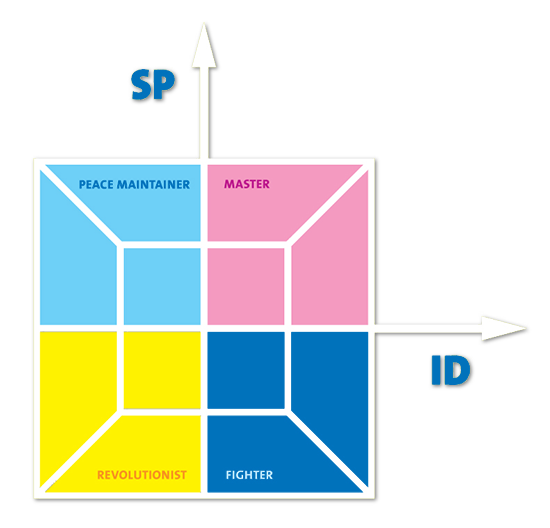Assuming that the sales individual’s (SAM, regional manager and so one) communicational quality has an influence on the trade of given product or service we are also assuming that tuning up and armouring quality of communication with effective practical techniques leads to increased trade as well.
Pure measurement of this relation is difficult because increased trade also depends on advertising, different market factors, support etc. More than that, in many cases developing a specific skill prevents us from decreasing trade. This is also difficult to prove.
Customers’ opinion concludes that SPID® system is a so called best practice on this field.
In our companys’s opinion, SPID® system is the(!) best practice on this field.
A SPID® is a dynamic system based on measurable and traceable individual development.Measurment includes 4 behavioural dimensions and the corresponding 4 communicational strategies which are as follows:
- S (Sympathy) – Sympathy gaining
- P (Partnership) – Relationship management
- I (Information) – Information gaining
- D (Defensivity) – Assertiveness.
Conscious mastering of these strategies leads to much more effective sales activity.
SPID® strategy is a ”double agent”, i.e. a situational communication strategy (the situation determines which of the four SPID® factors is dominant) and a process structure which usually starts with sympathy gaining followed by deepened relationship management with the partner than we find out (strive to find out) the informations which constantly shape our segmentation and negotiational position ( lots of time and money could be saved with not insisting too much on definitely closed doors), finally we assertively “collect” the promise and make our partner say further more of them.
The SPID® TRAINING AND QUESTIONNAIRE page contains all practical information about the system, here we focus on the relation between efficiency and the 4 dimensional skill development:
1. developing the S factor, making sympathy gaining a conscious act and measuring its consciousness.
Beeing sympathetic is an integrated result of our conscious and unconscious memories.
For example if we have to decide between two carpenters with the same ”technical” attributes (price, our belief in their professional skills, timing, etc) we will decide based on our sympathy and nothing else.
One thing is for sure: sympathy gaining is a consciously acquirable technique.
If our agent is more sympathetic to the customer than the other company’s agent, this is an opportunity worth to be taken seriously and used efficiently. This is a gate. This is the way sympathy gaining leads to increased business.
2. The meaning of the letter „P” is relationship management with the partner. Thanks to Rogers, the concept has a longer history than emotional intelligence, the latter “borrowed” from Rogers and made popular by Goleman. P factor measures something similar with EQ, i.e. the scale of consciousness within the relation management process.
The agent who consciously deepens the relation with the client uses relation itself as a fund for influencing the client’s behaviour, obviously with the goal of increasing the product’s trade.
3. ”I” stands for information gaining, conscious information gaining behaviour. Any conscious information “gainer” representant is fully aware of given time limits and manages the discussion by using smart questioning and listening(!) techniques creatively. Typical case is the “bigmouth rep”, with a highly negative I factor. The consciousness of information gaining leads to increased market by making 5, 10, 30, 60 min. negotiational situations much more efficient.
4. The meaning of „D” letter is assertiveness, that is enforcing our rights, defending ourselves by enforcing the rights we have. We have the right to sell more because it’s benefit brings us in the position of achieving the other goals we have. Low scaled D factor individuals are inhibited sales persons. There are some who can conceal it successfully, the „camouflage” works especially within good-reputation multi companies. By developing and consciously applying the D factor even these agents can achieve a higher efficiency thus can achieve a major increase in trade as well.

On the upper right quarter of the system of co-ordinates we can find the „Master“ quadrat, where are those participants who have successfully acquired, or possess on a certain level of the four basic types of communication. Theoreticaly the goal is to achieve this position in the system but determination of exact directions must always depend on the company’s profile.
The upper left quadrat represents the „Peace maintainer“, an individual who conciously applies S and P strategies, but rather ignores the other two.
The „Fighter“ (lower right quadrat) has a conscious control of I and D factors, on the other hand S and P factors of communication remain ignored.
Finally, the lower left quadrat denotes the „Revolutionist“ type, led mainly by his disposition and rarely beeing aware of the current situation and the appropiate strategy to be applied.

